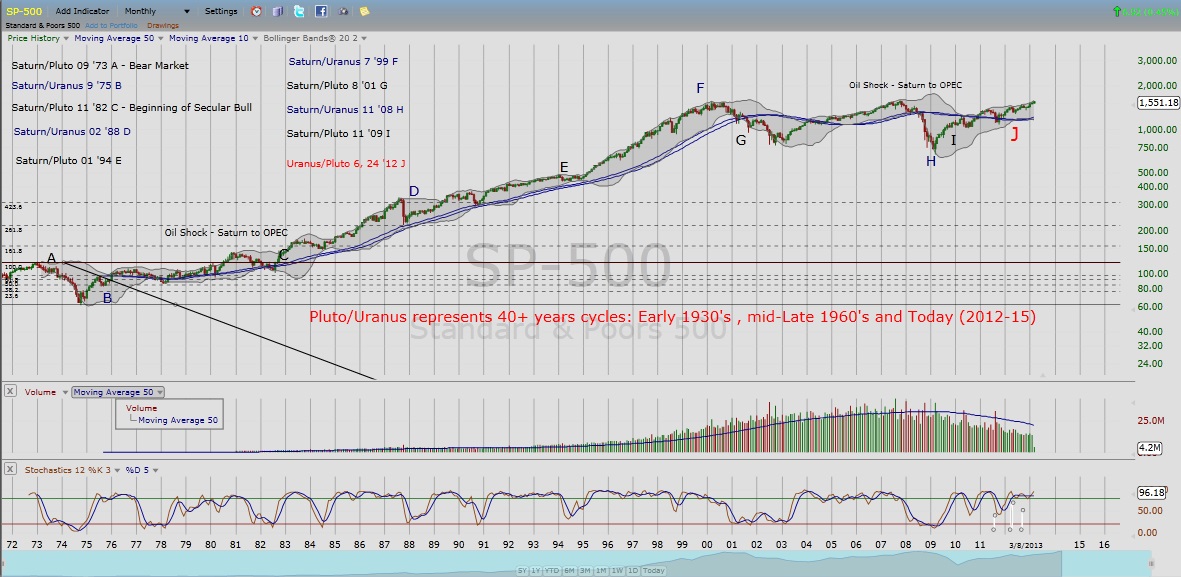 By Maria Rinehart What are planetary cycles? A planetary cycle is the period during which a planet completes its orbit around the sun, including its orbit in relation to other planets. In mundane astrology (social, political, and economic), we are concerned with the relative positioning of the outer planets (Saturn, Uranus, Neptune and Pluto) to each other. The outer planets represent longer term cycles and generational influences.
By Maria Rinehart What are planetary cycles? A planetary cycle is the period during which a planet completes its orbit around the sun, including its orbit in relation to other planets. In mundane astrology (social, political, and economic), we are concerned with the relative positioning of the outer planets (Saturn, Uranus, Neptune and Pluto) to each other. The outer planets represent longer term cycles and generational influences.
The chart below is the S&P 500 over the last 40 years. I have highlighted key dates when a given outer planet formed a ‘hard’ Ptolemaic aspect to another. Ptolemaic hard aspects are defined as the conjunction (0 degrees), the square (90 degrees), and the opposition (180 degrees). Due to the elliptical nature of the orbits, our perception of the planets’ orbits from Earth is that they will periodically retrograde so the planets often meet more than once per cycle. For simplicity, I have included only the initial contact. Click to enlarge.
Since the Great Recession, the astrological community has rallied around the implications of what both the Saturn-Uranus cycle (2009-2010) and the ongoing Pluto-Uranus cycle (2012-2015) have to tell us about the current period in history. The Saturn-Uranus cycle is seen about every 10 to 12 years, whereas the Pluto-Uranus cycle comes about once every 40 years. These cycles mirror the secular cycles that the market or the economy experiences over decades. For the astrological community, Pluto-Uranus is the big one, and is often a harbinger of political and social unrest. Refer back to the dates that the Pluto-Uranus cycles took place to intuitively understand this connection, e.g. the early 1930’s, the mid-late 1960’s, and today. In fact, Pluto and Uranus will meet a total of five times from 2012 to 2015. The first meetings were the summer of 2012 and September 2012. The next square will take place beginning May 16. Due to the slowness of the orbit, the exact aspect will remain for a couple weeks. Given the propensity of Pluto-Uranus to correlate with social unrest and rebellion, it is easy to connect the first squares this summer with the Egyptian presidential elections and the attack on the American embassy in Benghazi, Libya, respectively.
Back to the Markets
To understand these larger secular cycles, which coincide with Pluto-Uranus, the question is, “What are the common themes or drivers we can see around these times?” According to Ed Easterling’s work, Unexpected Returns: Understanding Secular Stock Market Cycles, secular cycles are driven largely by inflationary shifts (Easterling, 2005). The Roaring Twenties was followed by the debilitating deflation of the 1930’s; the bull market of the 1950’s was interrupted in the mid-60’s by high inflation, which reached double digits just before the secular bull of 1983-1999; and during the last decade, the celebration of the Great Moderation ended as deflation and another secular bear followed the euphoria of the dot.com bubble. It’s amazing not that history repeats itself, but that we forget the lessons of the past. Planetary cycles remind us of these lessons, giving us an objective measure of when to expect change. This is because it is often hard to imagine what’s around the bend while we are still psychologically attached to the recent past.
From the Market’s Standpoint, What Happened at Last Summer’s Pluto-Uranus square?
The long-term bond market showed long-term technical signs of peaking. At the New Year, the 20+ year Treasury (TLT) fell below its 10/50 weekly ma, a technical sign of weakness. This was also a signal to the markets that inflation had returned. From our price and time analysis of Google (GOOG), we demonstrated planetary stations can represent either a continuation or disruption to the current flow. Astrology timing signals and the incorporation of planetary cycles must always be confirmed by market action just like any other technical tool.
Pluto and Uranus will meet three more times before 2015. These events are potentially significant in the near term, but the extent and direction they will push the market is impossible to say. Additionally, there are still significant economic headwinds here and abroad. The early stages of any new trend are often challenging, with many stocks making repeated attempts and failures to break out of long term consolidation patterns until confidence builds. Still, the larger, trans-generational trend is bullish and the most likely scenario is that we are at the beginning of another great bull run.
References
- Easterling, Ed (2005). Unexpected Returns: Understanding Secular Stock Market Cycles. Cypress House: CA.
- Stock Charts by FreeStockCharts.com and astrological dates courtesy of Astro.com
Twitter: @RinehartMaria and @seeitmarket
No position in any of the mentioned securities at the time of publication.
Any opinions expressed herein are solely those of the author, and do not in any way represent the views or opinions of any other person or entity.









